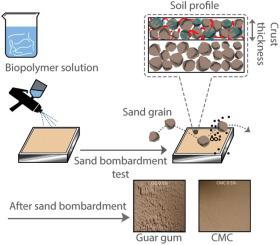Aeolian Research ( IF 3.3 ) Pub Date : 2021-03-23 , DOI: 10.1016/j.aeolia.2021.100696 Roozbeh Owji , Ghassem Habibagahi , Ehsan Nikooee , Sayed Fakhreddin Afzali

|
Wind erosion is a global environmental challenge. Its financial adverse effects on the societies as well as human health have demanded scientists to search for new solutions. The common mitigation techniques have high CO2 footprints and are not sustainable. One of the environmentally friendly techniques for this purpose is the use of biopolymers, however, their production is costly. The present study proposes the use of carboxymethyl cellulose for wind erosion control. Since carboxymethyl cellulose can be obtained from various waste sources, it is not only a sustainable treatment material but also an economical one. Therefore, a comprehensive experimental study inclusive of wind erosion experiments, wet-dry cycles durability assessment, analysis of partial treatment, and soil microfabric was conducted on treated samples. In addition to aerodynamic lift experiments in the wind tunnel, samples were exposed to sand bombardment to mimic the saltation phenomena. Furthermore, the performance of guar gum, a widely used biopolymer, was compared against carboxymethyl cellulose. Results of sand bombardment indicate that a relatively low concentration of 0.3% carboxymethyl cellulose can effectively reduce the soil loss, whereas, the sample treated with 0.3% guar gum experienced a considerable soil loss. Durability tests showed that the guar gum generated soil crust was completely destroyed at the beginning of 10th cycle while the crust produced by carboxymethyl cellulose could diminish the soil loss to less than 3% highlighting its adequate durability. Finally, to mimic the field condition, samples with untreated parts were studied which underscored the effective performance of the carboxymethyl cellulose treatments.
中文翻译:

使用羧甲基纤维素的风蚀控制:从喷砂性能到微结构分析
风蚀是全球环境挑战。它对社会以及人类健康的财务不利影响,要求科学家寻求新的解决方案。常见的缓解技术具有较高的CO 2含量脚印,是不可持续的。为此目的的一种环保技术是使用生物聚合物,但是,其生产成本很高。本研究提出使用羧甲基纤维素控制风蚀。由于羧甲基纤维素可从各种废物来源获得,因此它不仅是可持续的处理材料,而且还是经济的材料。因此,对处理过的样品进行了全面的实验研究,包括风蚀实验,干湿循环耐久性评估,部分处理分析和土壤微织物。除了在风洞中进行空气动力学升力实验外,还对样品进行了沙弹轰击,以模拟盐析现象。此外,瓜尔胶(一种广泛使用的生物聚合物)的性能 将其与羧甲基纤维素进行比较。沙击的结果表明,浓度相对较低的0.3%羧甲基纤维素可以有效减少土壤流失,而用0.3%瓜尔胶处理的样品则发生了相当大的土壤流失。耐久性测试表明,瓜尔胶产生的土壤结皮在第10个循环开始时被完全破坏,而羧甲基纤维素产生的结皮可将土壤损失减少至3%以下,从而突出了其足够的耐久性。最后,为了模拟野外条件,研究了未经处理零件的样品,这些样品强调了羧甲基纤维素处理的有效性能。用0.3%瓜尔豆胶处理过的样品发生了相当大的土壤流失。耐久性测试表明,瓜尔胶产生的土壤结皮在第10个循环开始时被完全破坏,而羧甲基纤维素产生的结皮可将土壤损失减少至3%以下,从而突出了其足够的耐久性。最后,为了模拟野外条件,研究了未经处理零件的样品,这些样品强调了羧甲基纤维素处理的有效性能。用0.3%瓜尔豆胶处理过的样品发生了相当大的土壤流失。耐久性测试表明,瓜尔胶产生的土壤结皮在第10个循环开始时被完全破坏,而羧甲基纤维素产生的结皮可将土壤损失减少至3%以下,从而突出了其足够的耐久性。最后,为了模拟野外条件,研究了未经处理零件的样品,这些样品强调了羧甲基纤维素处理的有效性能。



























 京公网安备 11010802027423号
京公网安备 11010802027423号